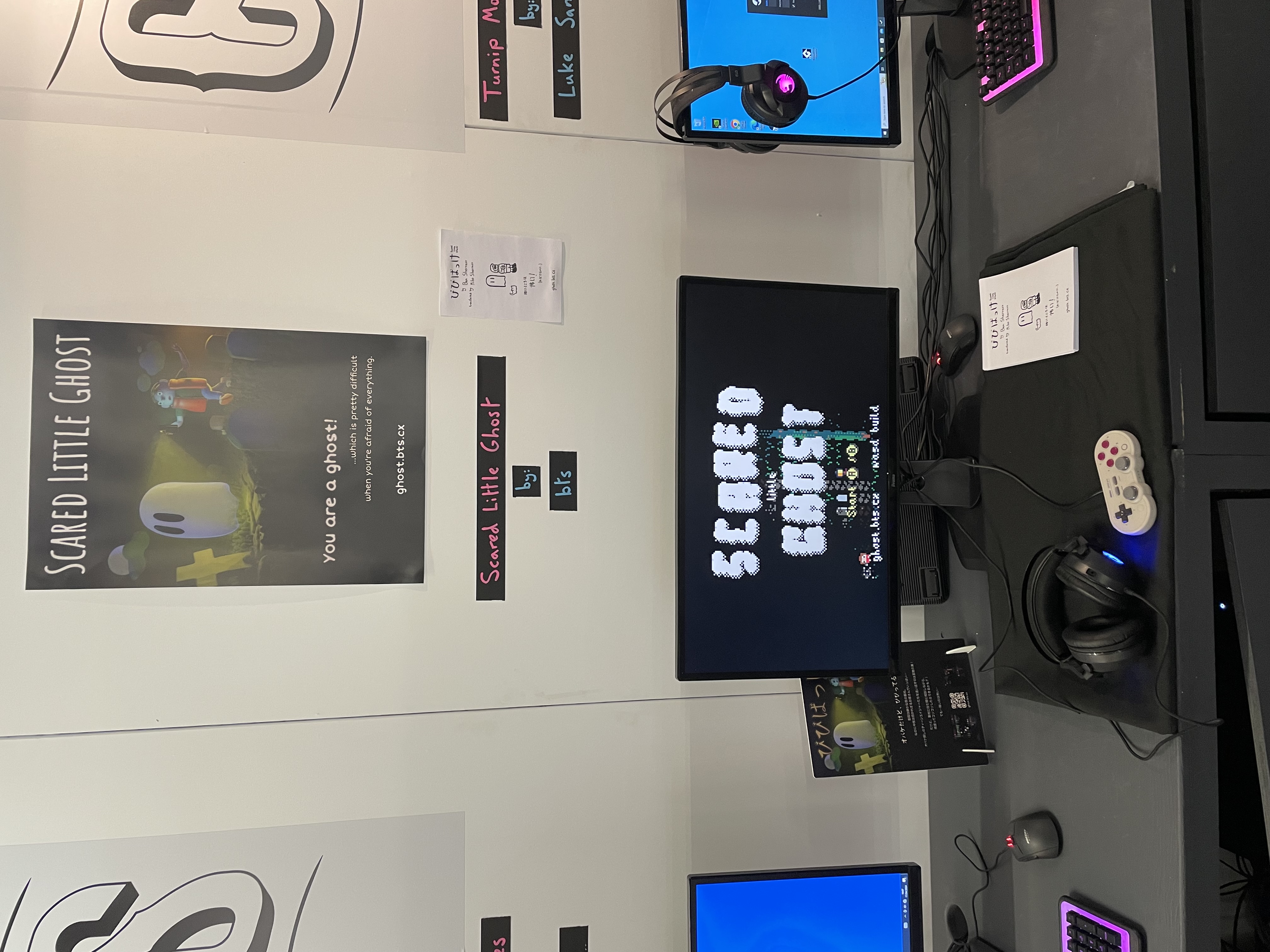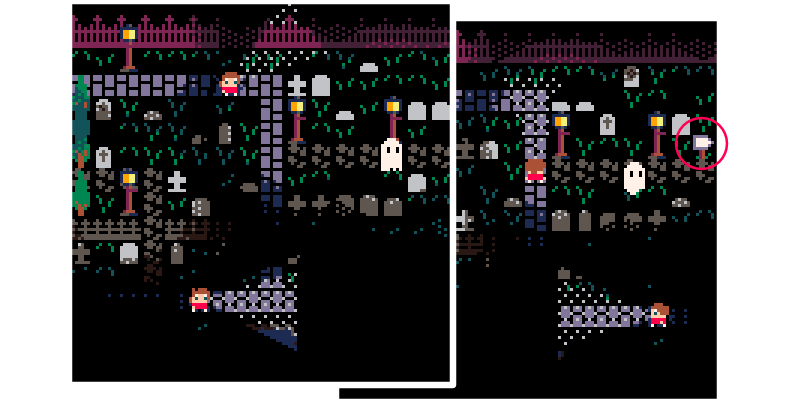WASD Retrospective
Monday, August 26th, 2024

In April I showed Scared Little Ghost at the WASD game show in London. If you're not familiar with the show, it's an indie-focused game show that replaced EGX Rezzed. It takes place every year over three days and it's pretty popular, attracting a lot of large publishers like Devolver Digital and Team17. However, it also has a number of smaller publisher and independent developers showing their games ... people like me!
I wanted to do a little post about how I came to do the show, how it went and some notes that might be helpful.
The Road to WASD
Exhibiting at a game show, especially one as big as WASD is not cheap. However, there is a showcase of smaller indie titles at every WASD called WASD Curios which is how I was able to exhibit. Curios is a selection of games curated from open submissions by David Hayward, those selected are invited to exhibit at WASD at no cost. The creators are welcome to attend, but David is also there to attend to any games whose creators are unable to do so. It receives many submissions every year and so the likelihood for selection isn't high, but it is extremely easy to submit your game to, and given that you don't have to attend it is also one of the cheapest ways for an independent developer to show their game at a large event. This is me urging you to apply for it when submissions open next year. 😜
I have applied for Curios a few times in the past, but have never been selected. I have even applied with Scared Little Ghost once before, which gave me pause to re-submit it this year. I was very surprised to receive a nice e-mail from David informing me of my selection and inviting me to attend the show. A pleasant surprise indeed. I live in Cambridge, which is about one hour away from London by train, so I decided to take time off work to attend.
From being selected to the time of the show there was about a month and a half worth of time to prepare. Having recently started a full-time job I wasn't able to do too much on the game, fortunately however it was already in a fairly showable state due to the version that I showed at Tokyo Sandbox last year. However, I did take some time to do two smaller fixes to the game which I thought were important - improving the rendering performance by adopting the new inverted drawing API added in Pico-8 0.2.6 and creating a new font and text layout system for the game that used proportional spacing to make it easier to read. I also made sure to 'fix' the button glyphs in the custom font to say 'A' and 'B' rather than 'O' and 'X' as I have found this makes the game more understandable for players who have never used Pico-8 controls before.
The other preparation I did was to print off a large A2 poster for the game with the game's key art. I wasn't able to do this using the original renderings supplied by Frankie, however he had also supplied the original Blender project file which meant I could re-render the key art at a size suitable for printing. I considered making new flyers for the game, but since I had a number of (Japanese language) fliers left over from Tokyo Sandbox that showed the game's URL (the only information you really need...) I decided to just take those. I honestly expect so many of them to end up in the waste paper bin by the evening... it's a saving for me. 😅
At the Show
I made the decision to commute each day for the show, instead of taking a hotel in London. This did make it pretty exhausting to commute into and out of London each day, but the combined total of the train tickets was still cheaper than one night in a reasonable hotel nearish to the venue. 😬
The venue itself is well situated in Spitalfields, a nice area of London. It takes about 5-10 minutes to walk to the building from London Liverpool Street station and it's pretty easy to find. About two years ago I went to the WASD held at Tobacco Dock, and whilst I did like that venue it was quite difficult to travel to - I definitely preferred this one. Check-in and finding the Curios stand was pretty painless, although the building generators had some issues the first morning and we weren't able to set up until about an hour before opening! That was fine for me though as I'd got a good build ready to go, and running Pico-8 games on new computers is usually not much more than putting the .exe onto the computer and double clicking!
I attended all three days of the show and it was pretty busy on every one of those, although the last day, a Saturday, definitely had more children and families attending. There seemed to be lots of people from different walks of life attending for various reasons which is always nice to see. The show had a number of different rooms, the main room where the main bulk of the games were situated was always extremely crowded, we were situated in the second room which also had pretty high footfall because you had to pass through it to go to the other rooms or the exit. Whilst it did get quite crowded at times it did seem to be a little more relaxed than the main hall.
Showing the Game
The setup for the booths at WASD was quite different to that at Tokyo Sandbox. Sandbox's booths were more similar to those that you might find at a convention or a festival, more like a stall where the creators or other staff can sit or stand on one side of the desk, and the players can sit at the game on the other side. The booths at WASD were more typical to a game show where there is a computer monitor set against a dividing wall upon which there are posters etc. for the game. This meant that exhibitors had to stand behind their game, unless you were one of the lucky exhibitors who were showing at one of the four stations at each end of the booth, as being located there allowed you to sit next to your game.
The main disadvantage to this kind of setup is perhaps obvious but it's worth stating - it's not immediately obvious to folks attending that the game is your game. In addition, because our side of the stand faced out into the room there was nowhere to stand to signify the game was my responsibility - I just looked like any other attendee who was shoulder watching. If I wanted to chat to anyone then I had to be proactive about making it known that I was the game's creator, and due to the traffic in the space this wasn't always easy. However, not being obvious did have the advantage that it was easier to hear people's candid reactions to the game and folks wouldn't have to feel like they had to play it through to not disappoint me or hurt my feelings, something I had considered whilst showing the game at Sandbox.
The players at WASD tended to fall into one of four major categories. Firstly, there were the folks who sat down and immediately decided the game wasn't for them and left. That's totally cool. Secondly, there were people who obviously very into the game, read all the dialogue, played it through and reached the end. Awesome. Thirdly there were some folks who seemed to be trying their best but weren't able to understand a key nuance of the game or were finding it tricky - Scared Little Ghost can be quite a tricky game and if possible I did try to assist these folks.
Then there was probably the largest category of players at WASD, button mashers. These players generally sat down, mashed through the explanation text, quickly found out that the game is quite slow paced and methodical or found out that they had no idea how to interact with the game and (in general) left soon after. One of the two show floor fixes I did to the game was actually to remove and condense some of the dialogue to try and make the text less lengthy, but I don't think this did much to help. I have mixed feelings about playing the game in this way but ultimately it's up to the attendees how they want to play things, but I would probably have reworked the demo to have given a much earlier payoff had I known that most people would approach the game in this fashion.

The second of the two show floor fixes I did was one single sprite which you can see in this screenshot. The first day of WASD I noticed that people were having issues with understanding that you could simply go offscreen to go to another area - unlike platformer games there really aren't visual 'choke points' that hint that this is possible. I didn't want to just put a big flashing arrow on the map so I considered for a bit what might be a 'naturally' occurring sign ... sign... post... signpost! So I added this one signpost sprite and it fixed the entire issue as no-one had the issue on any other day. It's risky to do show floor fixes, but absolutely worth it in this case.
Speaking of which, I lied previously because I did try and do one other show floor fix - a 5 minute reset timer where the game could self-reset after 5 minutes if no button input happened. I wanted this because as I mentioned before most folks would come, mash a few buttons and generally leave. However, this version of the game seemed to corrupt itself after a while so I reverted to the previous version. When making a more risky fix like this it's a great idea to have built a previous version with the less risky fixes in so you can just roll back to that, which is what I did. No laptop on the show floor for me! 😆
Notes
So, in conclusion, here's some notes of things I think are important for exhibiting at WASD specifically:
- Apply!!! As I mentioned before I'd applied to WASD Curios with the same game previously and it took until this year for it to be accepted. So don't give up!
- Folks will generally be looking for quicker games with a more immediate payoff so if your game is a bit of a slow burner it might be worth front loading something more interesting or skipping the story ahead entirely.
- If you want to be associated with your game then it's probably a good idea to have some T-shirts made with your game logo and 'I MADE THIS GAME' printed on it or something. 😆
Thanks so much to David for inviting me to WASD and for everyone who stopped by and played the game, you all rock.